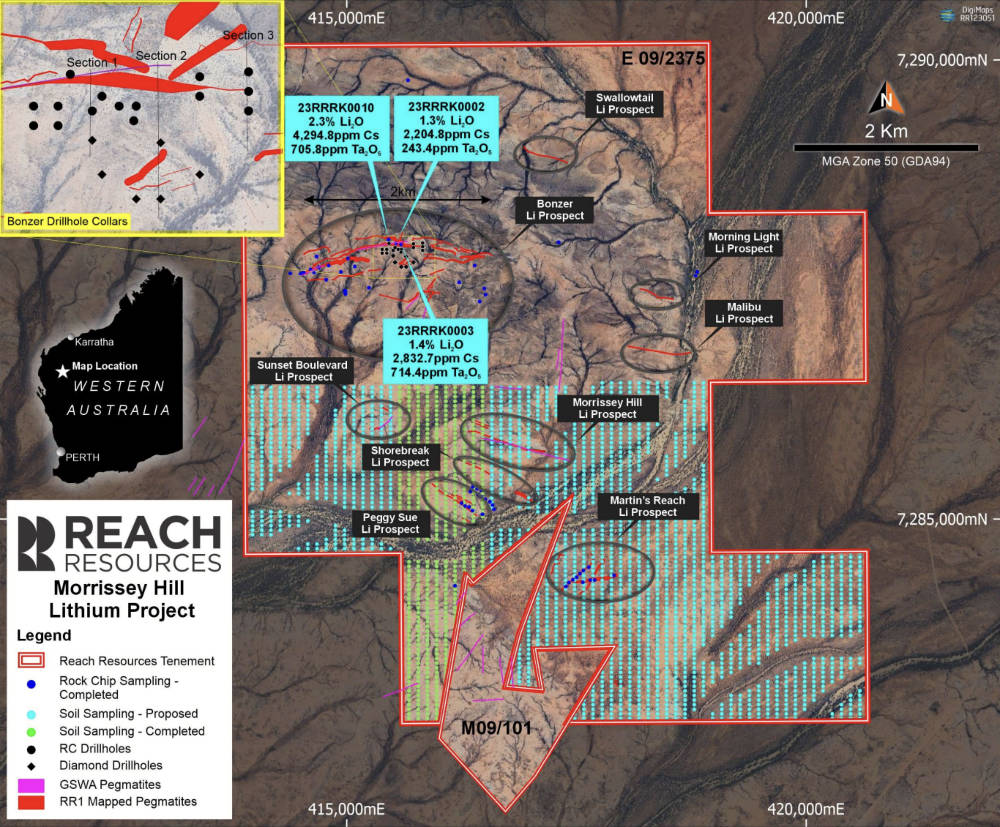Bonzer! Reach leaps straight into next round of drilling after proving up lithium system
Mining
Mining
Special Report: Reach Resources’ drilling has proven that a lithium system is present at the Bonzer prospect in WA after intersecting an extensive package of fertile pegmatites.
Bonzer is the top-ranked prospect within the company’s Morrissey Hill lithium project that shares the same system of rocks as Delta Lithium’s (ASX:DL1) Malinda prospect where hits such as 56m at 1.12% Li2O sparked a pegging rush in the Gascoyne.
Reach Resources (ASX:RR1) started systematic exploration of Morrissey Hill about nine months ago, completing a series of technically disciplined, methodical work programs that continue to deliver a large number of drill targets.
This included rock chip sampling at Bonzer that returned up to 2.3% Li2O across the +2km long pegmatite, leading the company to launch a Phase 1 drill program of 15 reverse circulation holes totalling 2,600m and six diamond holes totalling 1,900m.
The drilling tested a strike length of ~500m within the central part of Bonzer pegmatite system from surface to a total depth of 400m down-hole to determine the depth extent and subsurface continuity of surface lithium mineralisation identified from earlier soil and rock chip sampling.
It also recently acquired the M09/101 mining lease to expand its Morrissey Hill footprint and provide both logistical benefits and exploration opportunities.

Detailed analysis of results from this drill program by consulting geochemist Sugden Geoscience has confirmed that the Bonzer pegmatite system is lithium bearing, highly fractionated and indicative of a spodumene pegmatite type based on specific geochemical ratios and fractionation trends.
Principal lithium minerals identified during geological logging of diamond drill core include spodumene, lepidolite, zinnwaldite, garnet and tourmaline, supporting its potential to host significant lithium mineralisation.
RR1 added that while this initial drilling had returned lower grade mineralisation such as 18m grading 0.14% Li2O, the program could have hit the halo of a higher-grade zone.
“Our Phase 1, 4,500m drilling program at Bonzer was the first ever to have been undertaken at Morrissey Hill and we’re excited by the initial indications, and particularly with what the detailed geochemistry is telling us,” chief executive officer Jeremy Bower said.
“Assay results from the initial drill program should be viewed positively by those with a technical understanding of lithium mineralisation, despite not intersecting high grade results, yet.
“The results show that we have hit lithium mineralisation in a highly fractionated and fertile pegmatite system, but grade is lower in this area.”
He said that the drilling had only tested a 500m section of the +2,000m long pegmatite system while the intersection of lower grade lithium indicates that higher grades are possible nearby.
Additionally, fractionation ratios run by expert geochemist Steve Sugden has confirmed that Bonzer is a fertile, highly fractionated lithium bearing pegmatite system.
RR1 also has plenty of targets – with more than 50 pegmatites mapped – that remain untested.
“We have found the smoke, next we find the fire,” Bower added.
Demonstrating its confidence that it is on to something potentially rich, the company has doubled the size of the Phase 2 RC program to 9,000m and will start it immediately.
This will follow the plunge of mineralisation at Bonzer and also test other pegmatite targets.
RR1 will also carry out further analysis of all available drilling results to identify trends within the fractionation ratios, which has and will continue to provide greater confidence and insight for Phase 2 drilling.
Mineralogical analysis, such as x-ray diffraction (XRD), will be undertaken on the more significant intercepts to confirm mineralogy while further geological and structural mapping will be carried out to the northwest of the main drilling area where transported cover may be masking pegmatite extensions.
This article was developed in collaboration with Reach Resources, a Stockhead advertiser at the time of publishing.
This article does not constitute financial product advice. You should consider obtaining independent advice before making any financial decisions.